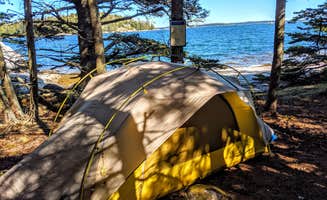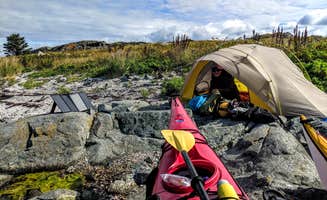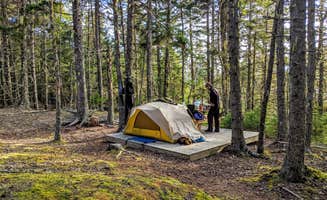Dispersed camping near Stonington, Maine requires water transportation and outdoor skills not common to mainland camping locations. The Deer Isle Archipelago contains several primitive island sites located between 2-5 miles offshore in the Gulf of Maine. These island campsites experience significant tidal fluctuations of 8-12 feet daily, which affects landing conditions and requires careful trip planning around tide charts.
What to do
Trail exploration on Marshall Island: The 985-acre Marshall Island offers a 10-mile perimeter trail maintained by Maine Coast Heritage Trust. "Despite the fact that the other islands had pesky mosquitoes, this site had none," notes visitor Shari G. about Marshall Island, who recommends bringing "fresh water (there is no fresh water for filtering) and wag bags (no toilets)."
Day trips to nearby locations: Wheat Island provides an excellent base for exploring Isle au Haut. According to one camper, it's "perfect for exploring the close-by Isle au Haut, a remote section of Acadia National Park, but very hard to get reservations at Duck Harbor Campground." Wheat Island offers two distinct camping areas with different capacities.
Beach combing: The shorelines around these islands contain various marine treasures. Doliver Island features a "gorgeous shell covered beach and a beautiful view of Isle au Haut, just next door," though landing can be difficult at high tide.
What campers like
Easy landing access: For those new to sea kayak camping, Buckle Island provides accessible shorelines. "This is a perfect island for those new to sea kayak camping as the sandy shore, which is exposed for a good portion of the day, is easy to land on and a short walk to a trail into the woods," according to one experienced kayaker.
Sunset views: Several islands offer prime sunset viewing locations. The southwest site on Wheat Island is "perfect for larger groups" and provides "a gorgeous view of the sun setting and full moon rising," reports a frequent visitor.
Isolation and solitude: The limited access nature of these primitive camping sites near Stonington ensures privacy even during peak summer months. The smaller site on Doliver Island offers complete seclusion with "barely a tent space, but a good stop for us on our 9 day journey and a perfect launching spot for crossing Jericho Bay (4.5 miles) to Marshall Island."
What you should know
Maine Island Trail Association membership: All these island camping locations require MITA membership for legitimate access. Sites operate on first-come, first-served basis and are free for members, but you must display your MITA flag on your watercraft.
Limited facilities: No islands have potable water sources or permanent toilet facilities. "Come prepared with fresh water and wag bags (no toilets)," advises a frequent visitor to these primitive camping sites.
Landing challenges: Several islands present landing difficulties depending on tide conditions. According to a visitor, Doliver Island "can be a tricky island to land on at high tide, so plan accordingly."
Insect preparedness: Seasonal mosquito activity varies by island and time of year. One camper at Wheat Island reports: "We thought we were passed mosquito season in early September, but alas, they were pretty bad at sunset."
Tips for camping with families
Site selection for children: Choose islands with gradual shorelines for easier access with younger campers. Buckle Island works well for families due to its "sandy shore, which is exposed for a good portion of the day, is easy to land on and a short walk to a trail into the woods."
Supply planning: Calculate extra water requirements when camping with children. Each person typically needs 2-3 liters daily, plus cooking water.
Emergency planning: Maintain VHF radio contact capabilities when camping with families. Cell service is unreliable, and weather conditions can change rapidly in the Gulf of Maine.
Tips from RVers
Alternative accommodations: Limited RV options exist in the Stonington area. Most RVers use mainland campgrounds as base camps and arrange day trips or overnight excursions with local outfitters to reach the islands.
Equipment transfer considerations: When transitioning from RV camping to primitive island camping, minimize gear to essential lightweight items that fit in watercraft.





